
Keith Sonnier discusses the works on view in Keith Sonnier: Early Neon at the Hall Art Foudation | Reading, Vermont.

Keith Sonnier discusses the works on view in Keith Sonnier: Early Neon at the Hall Art Foudation | Reading, Vermont.
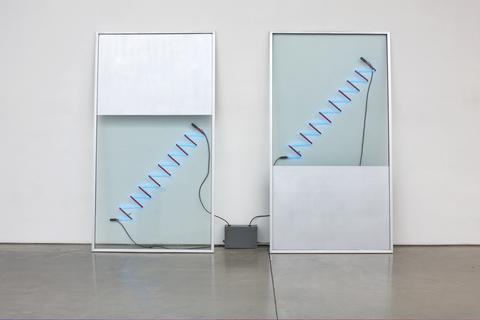
Keith Sonnier. Lac Prison, 1981. Hall Art Foundation. © Keith Sonnier
This particular one was made in 1981, and I used found extruded glass materials. This happened to be a kind of prison glass that was an architectural extrusion from a building, and we purchased these to make the sculpture – hence the title… because it was prison glass. Also I was working in Canada, and I was fascinated by my ancient Canadian heritage – of my father’s family coming from Nova Scotia. Lac Prison was a famous prison on the lake called Lac Prison, where French prisoners were held by the British.
[click below to hear more]
This early period of the late ‘60s is again a very fertile period for me. Not only were the neon and glass investigations introduced, but neon as a linear structure or a line of color, and its intricacy is what really drove me to new heights, especially in drawing. I never realized how important drawing was in making the work. I had always somehow drawn to get an idea. But beginning to draw to introduce structure as well as being able to lead to a shop drawing is what really expanded a way to design new work. And I also realized that I physically had to manipulate a line – meaning, I had to bend a piece of string or wire to really sense what this was, of how one material overlapped another.
[click below to hear more]
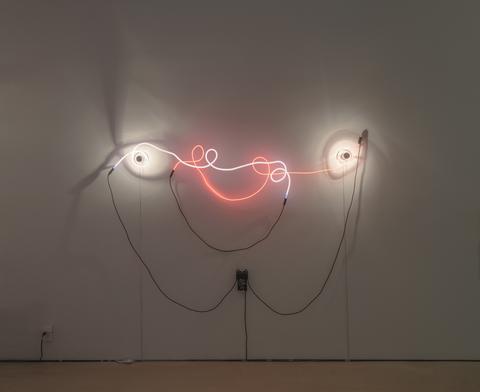
Keith Sonnier. Neon Wrapping Neon with Six Loops, 1969. Hall Art Foundation.
© Keith Sonnier
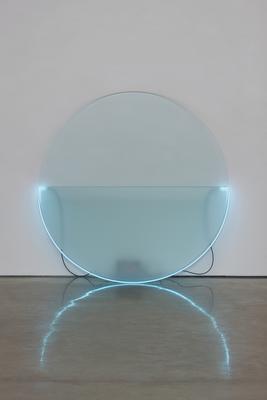
Keith Sonnier. Lit Circle Blue with Etched Glass
(Lit Circles Series), 1968. Hall Collection.
© Keith Sonnier
This is a combination of a cut circle and a slice – one half exactly – of a circle of etched glass. Drawings for these pieces were first made in the late ‘60s. And by ’68 I had made a series of neon pieces in combination with a variety of material – cloth, and then glass. And somehow when I shifted from glass to cloth, there was a translucency introduced into the works, and they began to expand volumetrically. And this changed the whole concept of me working with color and light. But the key to the color was it was a gas color. In this case, Argon gas, which tends to spread over a surface, especially a material like glass. And that was the big intrigue about this piece, which led to a large series of very big pieces entitled "Ba-O-Ba".
[click below to hear more]
The next work again goes back to very primitive ideas of sculpture, but using this technique of material that is stacked, or material that is laid and fabricated to create skin architecture. But rather than using the skin architecture of "Monticello Wall", I went back to even more primitive ideas for it – things as early as a real sculptural form, and very involved in early man, like the Venus de Milo. But after that, what really struck me as early sculptural shapes were the early Cycladic sculptures made in Greece. After observing and studying many of them, I made this series of "Cycladic Extrusions", I called them.
[click below to hear more]
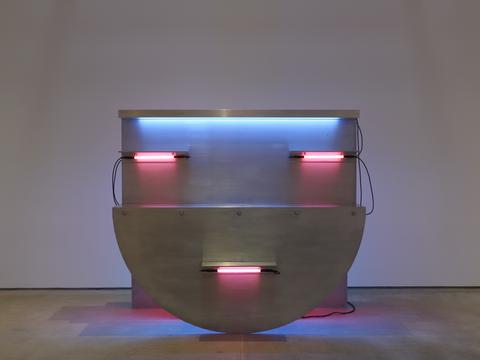
Keith Sonnier. Cycladic Extrusion II, 1988. Hall Art Foundation. © Keith Sonnier

Keith Sonnier. Kiosk II, 1987. Hall Art Foundation.
© Keith Sonnier
I decided that I needed to make freestanding work. And I again went and readdressed my early interest in architecture. And curiously enough read a lot about Thomas Jefferson’s construction of Monticello, and Monticello created an architectural principle called the Monticello Wall, which is how you get things to stand up straight, and it’s basically a perpendicular relationship of one freestanding plane to another free-standing plane, and it stands up in space. "Kiosk" is a large piece fabricated in Germany out of extruded material, again an architectural material. These large high beams were cut right from the assembly line, and they could stand up on themselves, but in order for them to take up space, I introduced these very thick planes of fabricated aluminum, or extruded aluminum plate. And this led to these particular works, especially "Kiosk which" addresses the same principle as the Monticello Wall.
[click below to hear more]
The importance of these "New Orleans Dyads" and a series of other "Dyad" pieces is that I lifted the piece from the floor, and they were put on extruded shelves like the freestanding "Cycladic" pieces, and one could literally slide glass and mirrors into them, so that you could begin to think of the piece as a kind of cinematic frame that you could move different images through. And of course the interesting thing about these pieces is that when you stand in front of the piece, you were reflected in the piece. So it forces the viewer to have a context not only to the architecture, where it’s being shown, but to physically be in the piece.
[click below to hear more]
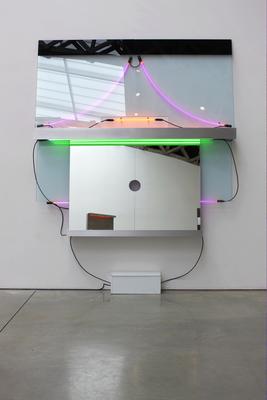
Keith Sonnier. New Orleans Dyad 1-A, 1989.
Hall Art Foundation. © Keith Sonnier
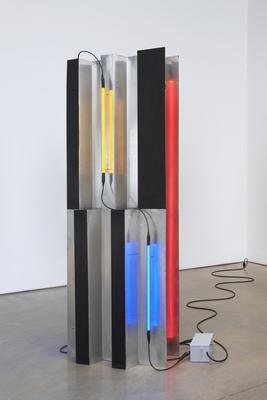
Keith Sonnier. Column I, 1981. Hall Art Foundation.
© Keith Sonnier
In this work entitled simply "Column I", again from the early ‘80s, I began to address other kinds of extruded material: steel, glass, aluminum, all kinds of architectural installation. This was the beginning of my interest in architecture, and especially what we in contemporary architectural terms called “skin architecture.” Our ancient architecture was based on the solidity of stone and the Pyramids, the Greek temples, the fabulous Inca temples... But this kind of approach to architecture is about layering in skin to make a structure. I would start out with a simple sheet of aluminum, and in order to create volume, I began to bend it in different ways. I worked with a fabricator who had all these bending devices. And after a series of bends were established, I combined them with the light. And all of a sudden this volumetric skin began to develop more volume, and it could actually stand on its own as a sculpture...
[click below to hear more]
